How to equip a dressing room?
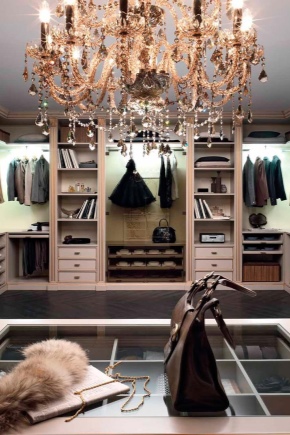
Every woman dreams of a comfortable and spacious dressing room in an apartment. All clothes, shoes and accessories can be stored in such a room. Contrary to popular belief, not only professionals, but also beginners can equip such a room.


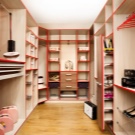



Features of the arrangement
In a practical dressing room, every corner should be used productively. Initially, you need to decide how many things you are going to store in such a room. After that, you can more accurately calculate the dimensions of the shelves and niches.
When organizing the space, conditionally divide it into several zones for placing things, depending on the frequency of their use.


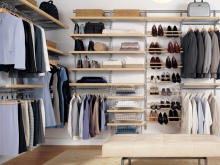
To fill a room, you should turn to the following storage systems for clothes and shoes:
- The grid (honeycomb) system consists of a carrier rail attached to the wall and shelves, drawers and compartments mounted to it. The popularity of such options is due to their dynamism. All functional elements in them can be rearranged or supplemented with something new.
Mesh systems easily fit into any room. This can be either a spacious or a very small room. Often, such copies are equipped with dressing rooms, pantries or large wardrobes.






- It is possible to form an attractive and original interior of the dressing room using a honeycomb system, trimmed with natural wood. Such specimens are multifunctional, practical and incredibly beautiful.


- A cheaper option is chipboard construction. It belongs to the budget category and is literally created for those who want to beautifully decorate a dressing room without spending a lot of money. Drawers and shelves made of such material look very harmonious and fresh in the conditions of dressing rooms, but in their practical characteristics they are inferior to cellular systems. In the formation of such structures, it is necessary to take into account the location of all objects in the room, since it will be difficult to make any changes later.
For more convenient storage of things in the room, you can install shelves, rods, hangers, hooks and baskets. With the help of such details, you can place outfits and accessories as neatly and practically as possible.





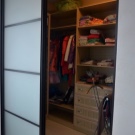
- Frame storage systems have a beautiful design. They are reliable and practical. In them, the supporting parts are metal racks, abutting against the floor and ceiling. These options look great in tandem with wooden shelves. Frame structures can be easily disassembled and reassembled.


When composing an attractive design of a dressing room, consider not only its functionality, but also its external performance. Recently, decorative baskets and wooden shelves, complemented by fabric details or straw compositions, have become very popular.
In large dressing rooms, you can place not only clothes, shoes and accessories, but also various household items. This can be an iron, vacuum cleaner, or ironing board. It is recommended to allocate a separate zone for them.
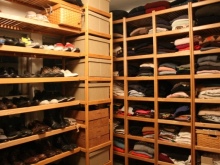


Types of dressing rooms
Dressing rooms differ from each other in layouts. Let's consider the most common options.
- Corner walk-in closets can be installed indoors without taking up a large area. Even in a small room, you can choose a place for such a design. It is necessary to pre-distribute things on the remaining area and decide where the furniture will be located.






- For spacious areas, linear options are suitable. Designers claim that such a dressing room is ideal for a room that is 3 by 1.5 m in size. This layout allows you to arrange things along one wall. Some people turn to another method: place hangers and shelves along both walls opposite each other.




- For a bedroom, the best option would be a g-like design. It is not necessary for her to have a separate room. You can simply select two walls for this structure in the corner without a window. The dimensions of this option depend on the free area.
In the L-shaped structure, you can not make open shelves. If such a design is located in the living room or bedroom, then it is better to give preference to closed specimens, because they will look more aesthetically pleasing.

- For an elongated area, an u-shaped dressing room will be an excellent solution. If you want to make this structure an extension of the room, then it will still look isolated, since it has three walls.
For an elongated area, an u-shaped dressing room will be an excellent solution. If you want to make this structure an extension of the room, then it will still look isolated, since it has three walls.

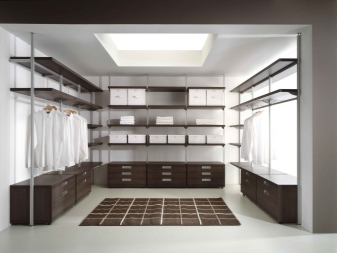


Space zoning
It is recommended to divide any dressing room into zones, regardless of its area. This is necessary for a more competent and convenient organization of the space.
- The lower area can be reserved for storing things that are not used very often. It is better to place drawers there for bed linen and other trifles. Shoes are often stored in this area. For such purposes, it is better to make high shelves so that women's boots can be stored on them without breaking.
- The middle zone should be set aside for the most frequently used items. Here you can install rods, hangers, shelves, etc. On large areas, you can put a lifting mechanism with a hanger, but it will be quite expensive. Such structures do not withstand large weights. It is better to equip shelves and drawers at eye level so that you can see how they are filled. There is a place for hooks in the middle zone. They are useful for temporary storage of clothes (for example, at the time of changing clothes).
- The upper area is for storing things that you temporarily do not use. These can be hats, caps, etc. Most often, such an area is installed under the ceiling and can be reached using a ladder.

Doors and lighting
If a separate room is allocated for the dressing room, then it must be equipped with a door. They should be selected based on the general style of the room:
- Doors with glass surfaces are in demand today. They can be matte, transparent, or decorated with patterns. Products with reflective inserts are notable for their practicality.
- Wooden or plastic specimens will look no worse.
- Wardrobe door designs are swing, sliding or folding (accordion doors).
The selection of a suitable specimen depends on the free area, layout and preferences of the owners.



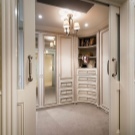


Lighting plays an important role in the dressing room:
- Often in such rooms there are ceiling lamps that illuminate even the most distant mezzanines.
- Hanging on the walls to illuminate the lower and middle zones will not be superfluous. The bulbs can be built into the boxes themselves or mounted on wall brackets.
- For corner walk-in closets, luminaires with clothespins that change the angles of inclination and direct the light to the right places are suitable.
- For such premises, it is worth choosing LED options. They do not heat up and are fireproof.
- Halogen lamps have powerful light, but they get very hot, so it is better not to keep them next to clothes.






Internal filling
Crossbars and hangers must be present in the wardrobe:
- There should be at least 165 cm of free space under the high rods. They are designed for dresses, raincoats and coats.
- The middle bar is suitable for blouses, shirts and jackets. The optimal length for this option is 80 - 100 cm.
A pantograph is a special retractable bar that can be lowered lower or raised to the upper tiers of the structure. Such a thing is ideal for storing off-season items.



- Trousers are folding and retractable. They need a free space of at least 60 cm in height.
- Roller boxes are needed for things that should be protected from dust. Small compartments for small items have dividers to keep the contents from mixing.
Drawers can be pulled out in whole or in part with a handle or push. Closers are available in many models.



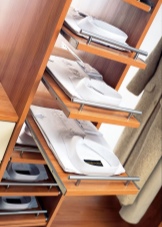
- Shelves in wardrobes can also be static or retractable. Their width should not exceed 30 cm. Copies from 60 cm should be installed in the mezzanine. They are suitable for storing large and heavy boxes.
- Boxes and baskets are suitable for small items and linen. As a rule, they are retractable and have roller mechanisms. Mesh boxes are suspended using special fasteners.
- The shoe racks have a slight slope. High-cut boots are hung on hooks to maintain shape and prevent kinks.
- Hangers and hooks are available for accessories (ties, hats, scarves, etc.). They are mounted on walls or doors.
















The comment was sent successfully.